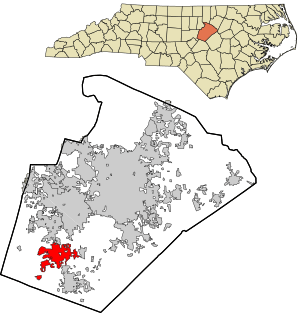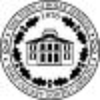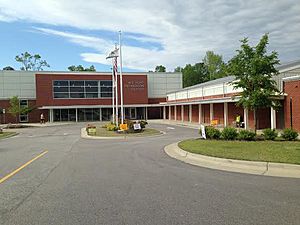Holly Springs, North Carolina facts for kids
Quick facts for kids
Holly Springs
|
|||
|---|---|---|---|
|
Town
|
|||

Downtown Holly Springs
|
|||
|
|||

Location in Wake County and the state of North Carolina
|
|||
| Country | United States | ||
| State | North Carolina | ||
| County | Wake | ||
| Area | |||
| • Total | 18.69 sq mi (48.39 km2) | ||
| • Land | 18.57 sq mi (48.08 km2) | ||
| • Water | 0.12 sq mi (0.31 km2) | ||
| Elevation | 423 ft (129 m) | ||
| Population
(2020)
|
|||
| • Total | 41,239 | ||
| • Density | 2,221.33/sq mi (857.65/km2) | ||
| Time zone | UTC−5 (Eastern (EST)) | ||
| • Summer (DST) | UTC−4 (EDT) | ||
| ZIP code |
27540
|
||
| Area code(s) | 919 | ||
| FIPS code | 37-32260 | ||
| GNIS feature ID | 2405854 | ||
Holly Springs is a town located in Wake County, North Carolina, United States. It's a growing community! In 2020, the town's population was 41,239 people. This was a big jump, about 67% more people than in 2010.
Contents
History of Holly Springs
How Holly Springs Got Its Name
The town of Holly Springs is named after natural springs. These springs flow freely and join to form a stream and a small lake. Around these waters, many large, old holly trees grew. That's how the name "Holly Springs" came to be!
Early Beginnings
Long ago, the Tuscarora Indians used the area around Holly Springs for hunting. Around 1720, this tribe left North Carolina because more Europeans were settling there. They later became the sixth nation of the Iroquois.
The town started to grow around these freshwater springs. These springs are believed to be the original "holly springs." They were located near where Avent Ferry Road and Cass Holt Road meet today. These roads were important because they connected Raleigh to the Cape Fear River and Fayetteville. They also linked Hillsborough to Smithfield.
The 1800s: Growth and Challenges
By 1800, a small village had formed at the crossroads. It had a general store built by Richard Jones, a Baptist church, and a Masonic lodge. In 1805, a Baptist minister named Needham Norris built his home, now called the Norris-Holland-Hare House. Soon after, a sawmill and a cotton gin were built.
Around 1817, Archibald Leslie, a tailor from Scotland, arrived. He opened a tailoring business and a store. He then started building a large house near the springs. This huge 38-room house, known today as the Leslie-Alford-Mims House, is still standing near Town Hall.
Holly Springs Baptist Church, started in 1822, was the town's first successful church. The Masonic Lodge #115 was formed in 1847. In 1854, they built a two-story lodge building. This building also served as one of the town's first schools. Holly Springs Academy opened in 1854 to prepare young men for Wake Forest College. Two years later, the first floor of the lodge was used as a school for local girls.
During the American Civil War, North Carolina joined the Confederate States Army. Many men from Holly Springs, including Captain Oscar R. Rand, joined the army. For example, at the Battle of Gettysburg, a unit of 880 soldiers from North Carolina lost most of its officers and many soldiers.
With the men gone, both schools in Holly Springs closed. The town became almost empty. When the Union Army moved north, Holly Springs was in its path. Groups of robbers called "bummers" raided farms and homes, taking food, supplies, and valuables.
For two weeks during the war, part of the Union Army camped near Holly Springs. They set up their headquarters in the Leslie-Alford-Mims House. Mrs. Leslie, who owned the house, treated the soldiers politely. This might have saved her home from being destroyed, which happened to many other large Southern houses. Union troops also used the Norris-Holland-Hare House as a hospital for their soldiers.
The Civil War left Holly Springs in a tough spot. Some families moved away. The nearby town of Apex got a railroad, which helped it connect to the outside world, but Holly Springs did not. In 1871, a historian described Holly Springs as "a deserted village."
The Town of Holly Springs was officially established in 1877.
In 1875, George Benton Alford moved his successful business to Holly Springs. He helped the town start to recover. A year later, he bought the Leslie house, which was a main building in the village. He added a lot to the house, making it one of the biggest mansions in Wake County. It even had its own ballroom!
Alford was a businessman and a politician. He started several businesses, like a store, a sawmill, and a cotton gin. He also helped start the Holly Springs Land and Improvement Company. He even started a newspaper, The Cape Fear Enterprise, to promote the town. He also helped get a charter for the Cape Fear and Northern Railroad, which later became the Durham and Southern Railway. After the war, there were attempts to restart the Holly Springs Academy, but they didn't work out. For a while, children were taught in private homes. Eventually, the Masons opened the first school for both boys and girls, with 125 students.
The 1900s: More Ups and Downs
In 1906, the town needed a bigger and better school. Leaders bought 10 acres of land near the springs for a new school. The first classes there began in 1908.
George Benton Alford dreamed of Holly Springs becoming a big industrial town with 10,000 people. The town's population was still small, around 300, but businesses and schools were attracting new people. However, World War I started, and many young men left to fight or work in war industries.
In 1923, Alford passed away, and the town lost a strong voice in politics. Then came the Great Depression. The Bank of Holly Springs, which had been around since before 1900, failed in 1924. Holly Springs faced hard times. Even though money from the Works Progress Administration helped build a school auditorium, the town missed out on new federal road projects that created jobs.
World War II also drew young people away from Holly Springs for war or city jobs. After the war, Holly Springs' population didn't grow much. In the early 1950s, while many towns were booming, Holly Springs stayed quiet.
In the early 1960s, the town's population was about 580. They installed new streetlights and widened Highway 55 (Main Street). The town even won an award for its clean-up efforts. During this time, several Black-owned businesses thrived, like a dry-cleaning business and a barbershop. The town board included many important Black citizens, such as James Norris, who became Holly Springs' first Black mayor. Later, Nancy Womble, Reverend Otis Byrd, and Parrish "Ham" Womble also joined the town council. Parrish Womble served for 28 years and was also interim mayor for a year.
During this period, Dessie Mae Womble was hired as the first Black female chief of police in North Carolina. As segregation ended, the Holly Springs School for Black students closed. Many students were bused to other communities for their education. This busing continued until the late 1990s, when Holly Springs Elementary School opened.
The town built its first sewage plant in 1987. After that, Holly Springs started to grow very quickly. It began to get people moving from nearby Cary and Apex. The population jumped from 900 in 1992 to about 6,000 in 1998, and then to nearly 25,000 in 2010!
The 2000s: Modern Growth
In December 2006, the Holly Springs Community Library opened. It's part of the Wake County Public Library system and also has a cultural arts facility.
On July 18, 2006, a company called Novartis announced it would build a factory in Holly Springs. This factory would make flu vaccines and create about 350 jobs. The factory was built on 167 acres (0.68 km2) in the Holly Springs Business Park. Construction finished in late 2008. Novartis invested at least $267 million in this project.
Town leaders believe Holly Springs is in a great spot for continued growth. It's only 18 miles (29 km) from Research Triangle Park (RTP), a major center for jobs and businesses.
On April 16, 2011, a large tornado touched down near the center of Holly Springs. It knocked down trees and damaged homes and buildings.
Geography of Holly Springs
Holly Springs covers a total area of about 39.2 square kilometers (15.1 square miles). A small part of this, about 0.3 square kilometers (0.12 square miles), is covered by water. The town of Apex is to the north, and Fuquay-Varina is to the south.
Population Information
| Historical population | |||
|---|---|---|---|
| Census | Pop. | %± | |
| 1890 | 218 | — | |
| 1900 | 219 | 0.5% | |
| 1910 | 261 | 19.2% | |
| 1920 | 333 | 27.6% | |
| 1930 | 362 | 8.7% | |
| 1940 | 394 | 8.8% | |
| 1950 | 406 | 3.0% | |
| 1960 | 558 | 37.4% | |
| 1970 | 697 | 24.9% | |
| 1980 | 688 | −1.3% | |
| 1990 | 908 | 32.0% | |
| 2000 | 9,192 | 912.3% | |
| 2010 | 24,661 | 168.3% | |
| 2020 | 41,239 | 67.2% | |
| U.S. Decennial Census | |||
Population in 2020
As of the 2020 United States census, Holly Springs had 41,239 people. There were 11,202 households and 9,307 families living in the town.
Here's a quick look at the racial makeup of Holly Springs in 2020:
| Race | Number | Percentage |
|---|---|---|
| White (not Hispanic) | 30,249 | 73.35% |
| Black or African American (not Hispanic) | 3,512 | 8.52% |
| Native American | 82 | 0.2% |
| Asian | 2,239 | 5.43% |
| Pacific Islander | 14 | 0.03% |
| Other/mixed | 2,252 | 5.46% |
| Hispanic or Latino | 2,891 | 7.01% |
Population in 2010
In the 2010 United States census, there were 24,661 people living in Holly Springs. There were 8,147 households and 6,706 families. This shows how much the town grew since the 2000 census, when there were 9,192 people.
About 55.5% of households had children under 18 living with them. The average household had about 3 people. The average family had about 3.38 people.
The median age in town was 33.1 years old. About 32.4% of the population was under 18. About 51.4% of the population was female, and 48.6% was male.
The median income for a household in Holly Springs was $85,000. For a family, it was $92,539.
Arts and Culture
Several historic buildings in Holly Springs are listed on the National Register of Historic Places. These include the Harrington-Dewar House, the Holly Springs Masonic Lodge, and the Leslie-Alford-Mims House. A special historical marker was also placed at the Norris-Holland-Hare House.
Sports in Holly Springs
The Holly Springs Salamanders are a collegiate summer baseball team. They were started in 2015 and play in the Coastal Plain League.
Parks and Recreation
Holly Springs has many great places for public recreation, including:
- Bass Lake Park
- Capital Area Greenway
- Holly Springs Cultural Center
- Jones Park
- North Main Athletic Complex
- Parrish Womble Park
- Sugg Farm Park
- W.E. Hunt Recreation Center
Education in Holly Springs
Public Charter Schools
- Pine Springs Preparatory Academy
Public Schools (Wake County Public School System)
- Holly Grove Elementary School
- Holly Ridge Elementary School
- Holly Springs Elementary School
- Oakview Elementary School
- Holly Ridge Middle School
- Holly Grove Middle School
- Holly Springs High School
Private Schools
- The New School Montessori Center
- Primrose School at Holly Grove
- Thales Academy at Holly Springs
Notable People from Holly Springs
- Andrew Capobianco: An Olympic diver who won a silver medal at the 2020 Summer Olympics.
- Daniel Dhers: A professional BMX rider.
- Brad Fritsch: A professional golfer.
- C. J. Leslie: A professional basketball player.
- Kiara Leslie: A WNBA basketball player.
- Cornelia Alice Norris: A socialite and genealogist.
- Hoke Norris: A journalist and author.
- Carlos Rodón: An MLB pitcher.
- Andrew Wantz: An MLB pitcher.
- Susana Žigante: A women's soccer player for the Croatia women's national team.
See also
 In Spanish: Holly Springs (Carolina del Norte) para niños
In Spanish: Holly Springs (Carolina del Norte) para niños






